标签:new include print 遍历 node c语言版 code style c++
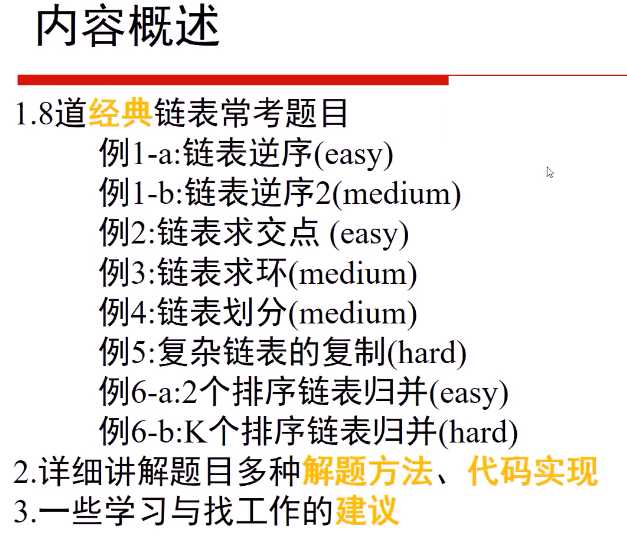
基础(c语言版)
1 #include <stdio.h> 2 struct ListNode { 3 int val; 4 struct ListNode* next; 5 }; 6 7 int main() { 8 struct ListNode node1; 9 struct ListNode node2; 10 struct ListNode node3; 11 struct ListNode node4; 12 struct ListNode node5; 13 14 node1.val = 10; 15 node2.val = 20; 16 node3.val = 30; 17 node4.val = 40; 18 node5.val = 50; 19 20 node1.next = &node2; 21 node2.next = &node3; 22 node3.next = &node4; 23 node4.next = &node5; 24 node5.next = NULL; 25 26 struct ListNode *pCurrent = &node1; 27 while (pCurrent != NULL) { 28 printf("%d \n", pCurrent->val); 29 pCurrent = pCurrent->next; 30 } 31 return 0; 32 } 33 /* 34 10 35 20 36 30 37 40 38 50 39 40 41 */
基础(c++版)
1 #include <stdio.h> 2 struct ListNode { 3 int val; 4 struct ListNode * next; 5 }; 6 7 int main(){ 8 9 ListNode node1; 10 ListNode node2; 11 ListNode node3; 12 ListNode node4; 13 ListNode node5; 14 15 node1.val = 10; 16 node2.val = 20; 17 node3.val = 30; 18 node4.val = 40; 19 node5.val = 50; 20 21 node1.next = &node2; 22 node2.next = &node3; 23 node3.next = &node4; 24 node4.next = &node5; 25 node5.next = NULL; 26 27 ListNode * pCurrent = &node1; 28 while(pCurrent != NULL){ 29 printf("%d \n",pCurrent->val); 30 pCurrent = pCurrent->next ; 31 } 32 return 0; 33 }
二者的主要区别是:c++ 可以没有 struct !

1 #include <iostream> 2 using namespace std; 3 4 //链表相关的基础 5 struct ListNode { 6 int val; 7 struct ListNode * next; 8 }; 9 10 struct ListNode * ListInit(){ 11 struct ListNode * head =(struct ListNode *)malloc(sizeof(struct ListNode)); 12 head->val = 0; 13 head->next = NULL; 14 15 return head; 16 } 17 void printList(struct ListNode * head){ 18 while(head != NULL){ 19 printf("Val: %d\n",head->val,head->next); 20 head = head->next; 21 } 22 } 23 void addOneNode(struct ListNode * head,int val){ 24 struct ListNode * newNode =(struct ListNode *)malloc(sizeof(struct ListNode)); 25 newNode->val = val; 26 newNode->next = NULL; 27 28 //遍历链表到 尾部 29 struct ListNode * temp = head; 30 while(temp->next !=NULL){ 31 temp = temp->next; 32 } 33 temp->next = newNode; 34 } 35 36 int main(){ 37 38 struct ListNode * head = ListInit(); //head存数据(默认存的值为0) 39 head->val = 1; //这里将默认的head.val =0 变为1 40 for(int i =2;i<10;++i){ 41 addOneNode(head,i); 42 } 43 printList(head); 44 return 0; 45 }

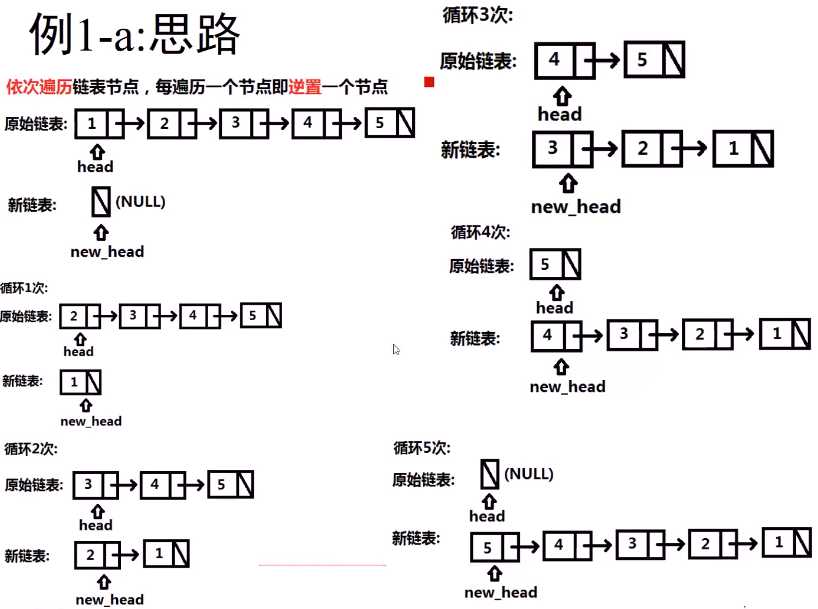
注:不允许申请额外的空间。
自己的代码:(缺点是:当head 为空的时候不能通过, 而且最后一个还要在循环外另外写一下!!! 优点是:它没有在循环中重复声明pNext变量)

1 #include <iostream> 2 using namespace std; 3 4 //链表相关的基础 5 struct ListNode { 6 int val; 7 struct ListNode * next; 8 }; 9 10 struct ListNode * ListInit(){ 11 struct ListNode * head =(struct ListNode *)malloc(sizeof(struct ListNode)); 12 head->val = 0; 13 head->next = NULL; 14 15 return head; 16 } 17 void printList(struct ListNode * head){ 18 while(head != NULL){ 19 printf("Val: %d ",head->val,head->next); 20 head = head->next; 21 } 22 } 23 void addOneNode(struct ListNode * head,int val){ 24 struct ListNode * newNode =(struct ListNode *)malloc(sizeof(struct ListNode)); 25 newNode->val = val; 26 newNode->next = NULL; 27 28 //遍历链表到 尾部 29 struct ListNode * temp = head; 30 while(temp->next !=NULL){ 31 temp = temp->next; 32 } 33 temp->next = newNode; 34 } 35 36 //链表逆序 (Leetcode 代码) 37 struct ListNode * reverseList(struct ListNode * head){ 38 struct ListNode * pPre = NULL; //保存前一个地址 39 struct ListNode * pNext = head->next; //保存下一个地址 40 while(pNext != NULL){ 41 head->next = pPre; //主 42 pPre = head; 43 44 head = pNext; //主 45 pNext = head->next; 46 } 47 head->next = pPre; //这个是因为最后一个连不上,所以最后要自己连上! 48 return head; 49 } 50 51 52 int main(){ 53 54 struct ListNode * head = ListInit(); //head存数据(默认存的值为0) 55 head->val = 1; //这里将默认的head.val =0 变为1 56 for(int i =2;i<10;++i){ 57 addOneNode(head,i); 58 } 59 printList(head); 60 head = reverseList(head); 61 printList(head); 62 63 return 0; 64 }
下面是老师的代码:
1 class Solution { 2 public: 3 ListNode* reverseList(ListNode* head) { 4 ListNode * newHead =NULL; 5 while(head){ 6 ListNode *temp = head->next; 7 head->next =newHead; 8 newHead = head; 9 10 head = temp; 11 } 12 return newHead; 13 14 } 15 };
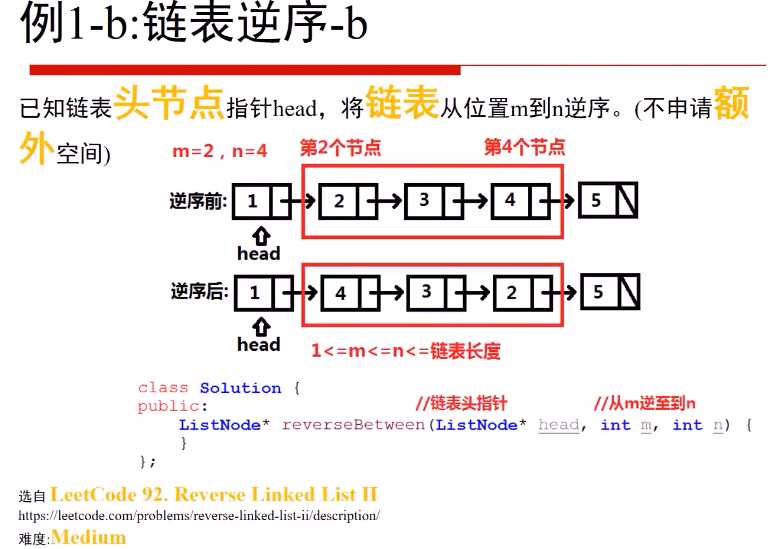
重要的四个结点:
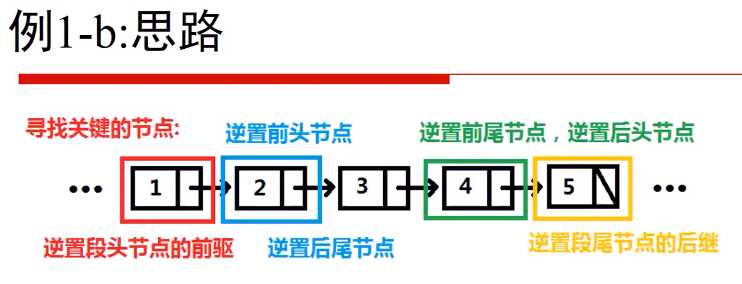
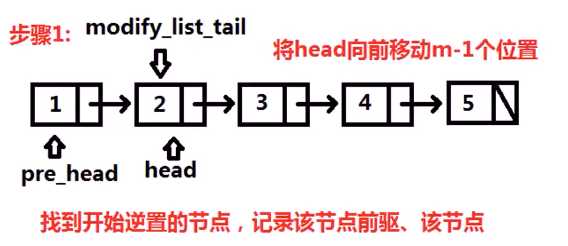
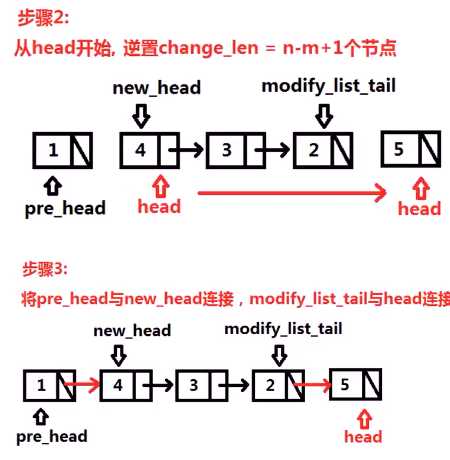


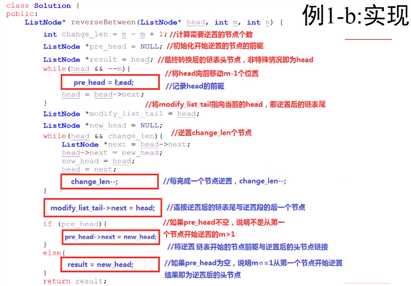
个人的思路:
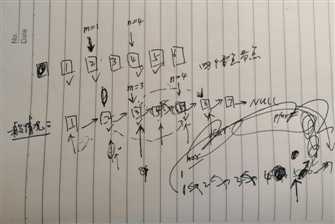

1 ListNode * reverseBetween(ListNode * head,int m,int n){ 2 if(head ==NULL || m==n) return head; 3 int flag = 0; 4 if(m==1) flag = 1; 5 ListNode* pCur = head; 6 for(int i =0;i<m-2;++i){ 7 pCur = pCur->next; 8 }//将pCur 遍历到 m前一个节点 9 10 ListNode* pBackWard = pCur; //记录 11 ListNode* pM = pCur->next; //记录 12 //开始逆序 13 pCur = pM; 14 if(flag) pCur = pBackWard; //特殊情景时修正下 15 ListNode * pPre = NULL; 16 for(int i =0;i<n-m;++i){ 17 ListNode * pNext = pCur->next;//本次 18 pCur->next = pPre;//主 19 pPre = pCur; //下次 20 pCur = pNext; //主 21 } 22 if(!flag){ 23 pBackWard->next = pCur; 24 ListNode * temp = pCur->next; 25 pCur->next = pPre; 26 pM->next = temp; 27 }else{ 28 head = pCur; 29 ListNode * temp = pCur->next; 30 pBackWard->next = temp; 31 head->next = pPre; 32 } 33 return head; 34 }
下面是老师的代码:
1 #include <stdio.h> 2 struct ListNode{ 3 int val; 4 struct ListNode *next; 5 }; 6 7 class Solution { 8 public: 9 ListNode* reverseBetween(ListNode* head, int m, int n) { 10 ListNode * pre_head = NULL; 11 ListNode * result = head; //最终返回的头节点 12 // 向前移动m-1 个位置 ,pre_head 和 head 一起移动 13 for (int i = 0; i < m - 1; ++i) { 14 pre_head = head; 15 head = head->next; 16 } 17 18 ListNode * modified_list_tail =head; 19 ListNode * new_head = NULL; //新的逆序链表的头 20 int change_node_num = n-m+1; 21 while(head &&change_node_num){ 22 ListNode * temp = head->next; 23 head->next = new_head; 24 new_head = head; 25 head = temp; 26 27 change_node_num--; 28 } 29 modified_list_tail->next = head; 30 31 if(pre_head){ 32 pre_head->next = new_head; 33 } 34 else{ //如果是从第一个开始就逆序的话, 特殊情况! 35 result = new_head; 36 } 37 return result; 38 } 39 };
标签:new include print 遍历 node c语言版 code style c++
原文地址:https://www.cnblogs.com/zach0812/p/11480529.html